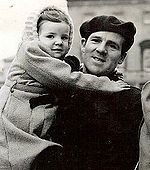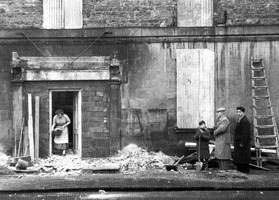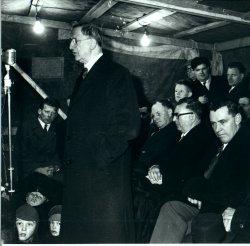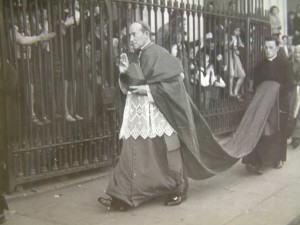The Election of Jack Murphy in 1957

Cathal Brennan looks at a rare, and fleeting, victory for an independent left-wing candidate in the conservative climate of 1950s Ireland.
In 1957 Jack Murphy was elected as the candidate of the Unemployed Protest Committee to put the issue of unemployment to the centre of political debate in Ireland.
Since the establishment of the Free State, unemployment and emigration had been a constant problem. The Irish National Unemployed Movement had been founded in 1926 and branches were formed throughout Ireland, north and south.
Irish socialists were heavily involved in the unemployed movement and used the issue to recruit activists to class politics and to highlight the failure of the two new states to address social problems.
The 1950’s – ‘A Decade of Stagnation’
The 1950’s in Ireland was a period of unemployment and high emigration. While most countries in Western Europe enjoyed a post war boom during the decade, the Irish economy stagnated. The economy faced deteriorating terms of trade and the relentless pursuit of deflationary policies discouraged investment in manufacturing and inhibited export development.[1]
While most countries in Western Europe enjoyed a post-war boom, the Irish economy stagnated.
By 1955 there was a balance of payments deficit of £35,000,000 and agricultural exports had declined considerably.[2] With high unemployment, emigration figures soared, with around 40 -50,000 people leaving the country every year.[3]
The second Inter Party government was in office from 1954 to 1957. The government was a coalition of Fine Gael, Labour, Clann na Talmhan, Clann na Poblachta and independents. The radical left were small and marginalised due to the intense anti – communist sentiment in Ireland at the time. The opposition party, Fianna Fáil, were still led by Éamon de Valera, who in 1957 was seventy five years old and almost completely blind.
The beginning of the Unemployed Protest Committee
Early in 1957 a group of unemployed building workers met at the Werburgh Street labour exchange and decided to call a public meeting to organise the unemployed and demand work.[4] Sam Nolan, in his article Story of a Victory, stated that, ‘the men round the Labour Exchanges decided soft soap was punk and decided to talk turkey. Some of them got a soapbox and voiced an angry protest on a shivering cold January morning.’[5]
Marches were preceded by coffins, ‘the only hope of the unemployed unless they did something for themselves’
From that meeting they organised an Unemployed Protest Committee and they secured a committee room in the premises of the Dublin Trade Union Council and a grant of £2.[6] The committee was made up of sixteen men with an average age of under thirty and all but three were married.[7] From the outset the committee was dominated by members of the small Irish communist movement.[8]
The Committee organised a series of public meetings and demonstrations throughout Dublin. Meetings were called outside labour exchanges in the city and support for the movement grew. Marches were usually preceded by home made black coffins, which had been a symbol of unemployed marches for many years.[9]
According to Nolan the coffins were, ‘symbolising the only hope the unemployed had unless they did something for themselves.’[10]
An election is called
Towards the close of 1956, the coalition government collapsed under the strain of economic problems and a dramatic outbreak of violence along the Irish border.

In December of 1956 the IRA launched Operation Harvest, a series of attacks on border fortifications in Northern Ireland. Gardaí were instructed to round up known republicans under the Offences Against the State Act and within days senior IRA personnel were being arrested in Garda raids.[11]
The National Executive of Clann na Poblachta met on the 26tth of January and voted for its TDs to withdraw support for the second Inter Party government.[12]
Two days later Seán MacBride tabled a motion of no confidence in the government on the basis of its failure, ‘to formulate and implement any long term economic development to ensure full employment, and its failure to make any effort towards the reunification of Ireland.’[13]
The UPC decided that the election would be a great opportunity to focus attention on the plight of the unemployed and to make jobs the central issue of the campaign.[14] Appeals were sent out for financial support and subscriptions were received from several trade unions, particularly in the construction sector, and also the Dublin, Belfast and Derry Trades Councils.[15]
Jack Murphy
The UPC decided to stand Jack Murphy as its candidate for a seat in the Dublin South Central constituency. The other potential candidate was Sam Nolan, a member of the UPC and the Irish Workers League (the communist party in the 26 counties). The committee sought a meeting with veteran left-republican Peadar O’Donnell to seek his help in raising funds for the UPC to pay for the election deposit. O’Donnell advised the campaign that many republicans who were sympathetic, and would donate money, would not get involved if Nolan was the candidate because of his membership of the IWL. The Soviet invasion of Hungary in 1956 had created a huge backlash against the communist movement in Ireland and their bookshop, New Books on Pearse Street, had been attacked by a crowd of over 3,000. [16]
‘I am against emigration for many reasons; one is that it wrecks family life’. Jack Murphy, 1957
There was a long history of socialists and the left wing of the IRA working together on issues of common concern. From the Civil War, through to opposition to the Cumann na nGaedhael government and the Blueshirts, to the attempt to join forces in the short lived Republican Congress, the two tendencies cooperated through a shared anti-imperialism.
The Republican Movement had struggled for a long time between those who thought the movement should embrace left wing agitational politics and those who felt these issues were a distraction from the main objective of securing a 32 county republic.
Jack Murphy was the thirty seven year old secretary of the UPC. He had joined the Fianna at age ten and then the IRA when he was sixteen. A militant shop steward, he had led a strike at the Poulaphouca dam project when he was an apprentice that had lasted several months.[17] In 1941 he was interned for his republican activities and spent the rest of The Emergency in the Curragh.
On returning to his trade after the war he was again elected as a shop steward and took part in many strikes. In 1956 he emigrated to England to find work but returned to Ireland after four months.
He later said: ‘I am against emigration for many reasons; one is that it wrecks family life. When I worked in England I nearly broke my heart thinking of my wife and youngsters all the time I was there. Here in Ireland the clergy and politicians are always preaching about the sanctity of the Christian family, but they do nothing about the unemployment and emigration that is breaking up thousands of families.’[18]
Murphy was a practicing Catholic and believed that the church had a positive role to play in pressuring the government into implementing policies to deal with unemployment.
Martin Mooney’s profile of Murphy in the Irish Democrat stated, ‘The only way to fight unemployment was to do it in Ireland with an organised movement. Work could and must be made available to the people. He saw it quite clearly – Irish capital was being exported abroad and the Irish working class were being exported with it.’[20]
Many Labour Party members in the constituency decided to campaign for Murphy
The Labour Party chose James Connolly’s son, Roddy, to fight the election despite the fact that he had no real relationship with the constituency.[21] Connolly’s prospects weren’t helped by the decision of many Labour Party members in the constituency to campaign for Murphy.
As Mary McConnell stated in Protest (the paper of the UPC), ‘there are a great many people in the country who feel as I do and have been trying for many years to find a way to work for the beginning of the establishment of [James] Connolly’s Ireland. Some of us hoped to do this within the Labour Party, by trying to change or influence the leadership, but I now believe that that is a hopeless case.’[22]
On the other hand the UPC ran a vigorous campaign and as Nolan wrote they had, ‘one asset the others hadn’t. It had willing, unemployed men who went out in great numbers to spread Jack Murphy’s name and his message of revolt.’[23] Unemployed painters hand painted hundreds of posters and whitewashed slogans all over the constituency.[24] The campaign drew huge attention to the issue of unemployment and attracted left wing activists from all over Dublin.
The general election was held on the 5th of March 1957. Jack Murphy took a seat in Dublin South Central with 3,036 first preferences.[25] Both the Labour Party and Clann na Poblachta failed to get seats in the constituency.

In the general election, Fianna Fáil won 78 seats and was returned to government with an overall majority. The election was a poor result for the government parties. De Valera returned as Taoiseach with his largest majority ever.
Fine Gael lost ten seats; Labour lost seven, Clann na Talmhan lost two while Clann na Poblachta was reduced to a single seat in the Dáil.[26] Sinn Féin won four seats, and over 65,000 votes, which they refused to take as abstentionists. Murphy’s profile as an ex – IRA man and a former internee must have been a bonus to his campaign in the circumstances. The deaths of Seán South and Fergal O’Hanlon, during the failed attempt to attack Brookeborough RUC barracks in January of 1957, had created huge sympathy for the IRA and over 50,000 people attended their funerals.
The Labour Party, which theoretically should have gained from the deteriorating economic situation and the twin problems of unemployment and emigration, was rejected by the electorate. According to Niamh Purséil, ‘with the exception of subsidies and a few small pension increases, Labour left no imprint on government policy.’[27]
Unfortunately for the Labour Party, their period in the Inter Party government of 1954 – 57 was marked by high unemployment, high emigration and high prices. The election results appeared to vindicate the stance of the anti – coalitionist left within the party who argued that coalition with Fine Gael could not deliver to results to Labour voters.
Reactions
Murphy’s victory was viewed as a tremendous result by the left in Ireland.
In an editorial article entitled ‘Opportunity’ the Irish Democrat stated that the election of Murphy, ‘breaks the long succession of retreats and disappointments which have all but broken the heart of the Irish Labour movement. It’s [the UPC’s] peculiar effectiveness is due to its having abandoned the notion that unemployment is the concern only of the unemployed.’[28]
‘it is the committee’s intention to keep a city full of angry people at the heels of the government’
All contributors to the paper were agreed on one point, that Murphy’s election should be viewed as a start to increased action by the committee rather than as an end in itself. ‘Broadly speaking the victory won will be consolidated insofar as the public offensive can be kept up.’ Nolan wrote that the struggle would continue both inside and outside the Dáil and, ‘it is the committee’s intention to keep a city full of angry people at the heels of the government and see they carry out their election promises.’[29]
Martin Mooney ended his profile of Murphy by writing, ‘John Murphy cannot go wrong.’[30] But a more prophetic note was struck in the Opportunity article. ‘Mr. Murphy will be surrounded by men who will lack no subtlety in finding ways to get at him. Attempts to divert him from his chosen path will be made under very clever camouflage. Of that there is no doubt.’[31]
In the Dáil / Hunger strike

Murphy had difficulty trying to get answers to even the most basic questions in the Dáil. He could not even get an answer to how much unemployment relief money was being spent in Dublin.[32]
In May Murphy and two other members of the UPC, Tommy Kavanagh and Jimmy Byrne, began a hunger strike to highlight unemployment and to protest against the removal of food subsidies in the budget.[33]
The hunger strike lasted four days and each evening thousands of protestors gathered on the corners of Abbey Street and O’Connell Street.[34] Resolutions of support came in from trade union branches all over the country and there were demands for a one day strike.
Murphy then fell ill and Kavanagh and Byrne called off the strike on the fourth day. To save face, the UPC arranged for trade union leaders to appeal for its end in order to avoid loss of life.[35]
The way the hunger strike fell apart led to confusion and demoralisation in the movement. Activists such as Sam Nolan felt that the Committee should focus on protests that included the wider community and in that way politicise them, rather than engage in individual actions such as hunger strikes.
In a speech delivered shortly after the hunger strike had ended, Seán Lemass warned that, ‘there are people who are even now meeting and calculating how to foster discontent for ulterior motives out of our difficulties and to weaken our will to tackle them.’[36]
Two days later, over three thousand women, many pushing prams or carrying children in their arms, marched to Dáil Éireann on the 22nd of May before attending a rally at College Green.[37]
Following the hunger strike Murphy had a meeting with the Archbishop of Dublin, Dr. John Charles McQuaid. McQuaid warned Murphy about the dangers of associating with communists and urged him to break with the UPC. He warned Murphy that Sam Nolan was the most dangerous man in the country and to break his ties with him.[4]
The last big demonstration of the campaign saw 2,000 protestors march from Seán McDermott Street to the Dáil but Murphy opposed the march saying it conflicted with his Dáil work.[38]
In August he broke with the UPC and the following year he resigned his seat, which was won by Fianna Fáil in the bye-election.[39] Murphy emigrated to Canada shortly afterwards.
Aftermath
In their coverage of the resignation, the Irish Democrat hinted at McQuaid’s role when they wrote, ‘powerful forces combined to attack him. These forces revolved around some of the most exalted personages in Dublin. In a sense there was a second “Browne Case” only Murphy was not a minister.’[40]
The article was referring to Dr. Noel Browne, the Minister for Health who resigned following his failure to get his cabinet colleagues to back his Mother and Child Scheme after the hierarchy had expressed their opposition to the legislation. He caused a sensation by subsequently publishing the correspondence between himself and the bishops.
The UPC showed the potential for a borader campaign, unfortunately it proved to be another false dawn for the Irish left.
The Irish Democrat summed up a lot of the views of the Irish left when they stated that, ‘he [Murphy] was quite right to say there was appalling indifference towards the unemployed. How sad he was not man enough to stay and fight it!’[41]
The election of Murphy also shows the disillusionment many felt with the Labour Party. After the two Inter Party governments there were very few tangible benefits they could show to their supporters.
Many Labour Party members in Dublin South Central were active in the UPC campaign in opposition to their own candidate. Noel Browne’s short lived National Progressive Democrats also attracted converts from Labour. According to J.J. Lee, Sinn Féin’s success at the general election, ‘appears to have partly reflected its apparent commitment to a radical social policy in a period of economic crisis as well as support for the border campaign.’[42]
Although the UPC campaign ended in a fiasco with Murphy’s resignation it showed the potential for a broader campaign that would include the unemployed and working class throughout the country. Without the safety valve of emigration the state could have faced massive social turmoil due to the high levels of unemployment during the decade.
Unfortunately for those involved, the UPC represented another false dawn for the Irish left.
Bibliography:
Communist Party of Ireland – An Outline History (Dublin, 1974).
Daly, Mary E., The Slow Failure Population Decline and Independent Ireland 1922 – 1973 (London, 2006).
Jackson, Alvin, Ireland 1798 – 1998 (London, 1999).
Lee, J.J., Ireland 1912 – 1985 (Cambridge, 1989).
King, Joe, Workers Solidarity #33 (Dublin, 1991).
Purséil, Niamh, The Irish Labour Party 1922 – 1973 (Dublin, 2007).
The Irish Democrat, #148 (London, April 1957).
The Irish Democrat, # 162 (London, June 1958).
Interview with Sam Nolan, http://.vimeo.com/11594569
Interview with Sam Nolan, http://vimeo.com/11706750
Footnotes:
[1] Lee, J.J., Ireland 1912 – 1985 (Cambridge 1989), p. 325.
[3] Jackson, Alvin, Ireland 1798 – 1998 (London 1999), p. 316.
[4] Communist Party of Ireland – An Outline History, p. 59.
[5] The Irish Democrat, (London), April 1957, p. 5.
[6] Communist Party of Ireland – An Outline History, p. 59.
[7] The Irish Democrat, (London), April 1957, p. 5.
[8] Daly, Mary E., The Slow Failure (London 2006), P. 202
[9] Communist Party of Ireland – An Outline History, p. 59.
[10] The Irish Democrat, (London), April 1957, p. 5.
[11] Purséil, Niamh, The Irish Labour Party 1922-73 (Dublin, 2007) p. 197.
[13] Irish Times, 29 Jan, 1957.
[14] Communist Party of Ireland – An Outline History, p. 59.
[16] Purséil, Niamh, The Irish Labour Party 1922-73 (Dublin, 2007) p. 196.
[17] The Irish Democrat, (London), April 1957, p. 5.
[18] The man in the black beret leads the battle for Éire’s workless by Andrew Boyd (1957)
[19] The Irish Democrat, (London), April 1957, p. 5.
[20] Purséil, Niamh, The Irish Labour Party 1922-73 (Dublin, 2007) p. 198.
[23] The Irish Democrat, (London), April 1957, p. 5.
[25] http://electionsireland.org/result.cfm?election=1957&cons=103
[26] Purséil, Niamh, The Irish Labour Party 1922-73 (Dublin, 2007) p. 200.
[28} The Irish Democrat, (London), April 1957, p. 5.
[32] King, Joe, “When the unemployed elected their own TD“, Workers Solidarity 33 (1991).
[33] Daly, Mary E., The Slow Failure (London 2006), P. 202.
[34] King, Joe, “When the unemployed elected their own TD“, Workers Solidarity 33 (1991).
[36] The Irish Times, 20 May, 1957.
[37] Daly, Mary E., The Slow Failure (London 2006), P. 203.
[38] King, Joe, “When the unemployed elected their own TD“, Workers Solidarity 33 (1991).
Ibid.
[39] http://electionsireland.org/result.cfm?election=1957B&cons=103&ref=69
[40] The Irish Democrat, (London), June 1958, p. 1.
[42]Lee, J.J., Ireland 1912 – 1985 (Cambridge 1989), p. 327.
Other:
[1]Communist Party of Ireland – An Outline History, p. 57.
[2]Interview with Sam Nolan, http://.vimeo.com/11594569
[3]Interview with Sam Nolan, http://vimeo.com/11706750
[4]Ibid.